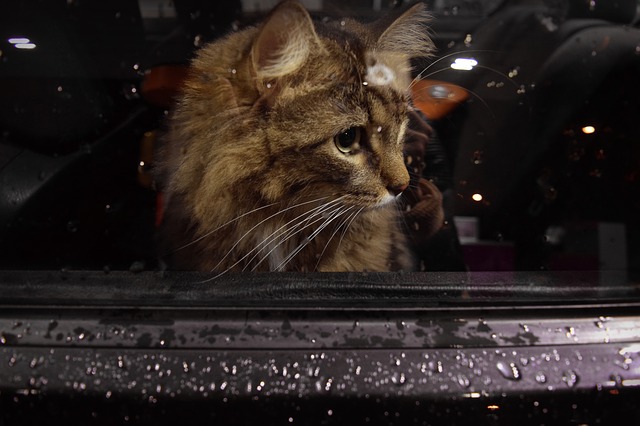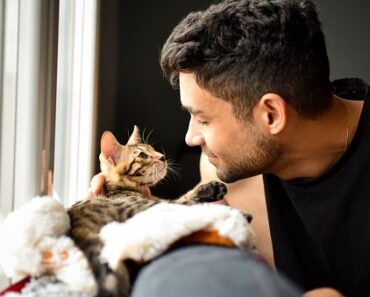
The cat is a very fearful animal, so if you plan to take him to the vet, you should not put him in a basket or carrier bag at the last minute, without having prepared him beforehand. Here are a few precautions to take to ensure your cat’s comfort and peace of mind before and during his trip.
Before leaving
Whether it is a crate, basket, bag or cage, the carrier must be a comfortable and comforting place for the animal. This is why we recommend that you place a comfortable blanket or cushion inside, if possible impregnated with its scent. However, it is important to avoid at all costs that your cat discovers the carrier on the very day of departure, which would cause him intense stress.
It is therefore advisable to take the object out several days or even weeks in advance, by placing it in a corner where your cat feels safe, such as the living room, eating area or playroom. Your carrier should be open and clearly visible to the cat, to arouse its curiosity. It is recommended that you place a toy that your cat particularly likes to encourage him to visit it. Then give him treats to reward him for coming to his cage. The cat will then associate the place with play, relaxation, meals and, more generally, a safe and comforting experience at home.
The ideal is to get him used to visiting the place regularly and on his own, without ever forcing him to go there, so that he can make it his own. This will make it much less difficult to force him to go inside when he leaves. If you catch your cat lying down in his crate, it is because he is starting to feel really comfortable in it. The size of the carrier should not be too small or too large for him to feel comfortable: the animal should barely be able to stand upright inside.
Once your tomcat has become accustomed to his cage, plan several walks around the house at a slow pace to get him used to being in an enclosed area. Close the cage gently and then lock it. Choose a basket that is securely closed and the cat won’t be able to get out.
Avoid feeding the cat just before the trip so that it doesn’t vomit during the trip. Allow your cat time to digest her meal and, ideally, to relieve herself before leaving.
Always clean the carrier, if possible several days before you leave. This will eliminate the odours of any other animals that may have been in the carrier before him, but also his own odour if he has made unpleasant visits in the past. Half an hour before departure, spray his crate with Feliway, in the four corners of the box and in the center. The synthetic F3 pheromones it diffuses, odorless to humans, will make this place soothing for your cat.
Also, it is not uncommon for anxious cats to urinate. For greater hygiene, you should place a disposable towel or mat on the floor of your carrier to prevent the cat from urinating. Also spray the towel or mat with Feliway Spray. Also note that a removable carrier with a removable lid will be easier to clean.
Finally, don’t hesitate to give your cat capsules such as Zylkene, which have no adverse effects, that can be opened and mixed with his food to reduce his anxiety, or dress him in an anti-stress T-shirt. If in doubt, consult your veterinarian.
During the trip
Cats generally do not like cars. At the risk of stating the obvious, never put your cat in the trunk! Imperatively place its cage (or other type of carrier) on the back seat of your vehicle, with the opening against the back of the seat and fastened with a seat belt so that your pet does not roll over or fall out. In the event of an accident, this will prevent both the object from becoming a deadly projectile for the driver and passenger and the cat from being violently ejected from the vehicle before being run over by the cars behind.
Place a sheet on its cage so that it cannot see the road, which could frighten it. In addition, cats have excellent night vision and like to be in the dark because it gives them a sense of security. If your trip is on a hot day, protect the animal from the sun by installing a sun visor on the window or by lightly moistening the cloth covering the carrier.
The car must be at a temperature suitable for the cat, neither too hot nor too cold. It must be well ventilated before the animal is loaded into the vehicle. Make sure that the air conditioning and heating are in working order.
Never allow your cat to wander outside of its place of transport. A cat that moves around freely in the car is very dangerous. Not only can it scratch your seats, but it can also cause an accident. The cat’s good behavior will determine the driver’s good behavior. So, wanting to hold him in his arms during the trip is a very bad idea!
If your cat is constantly meowing during your trip, ignore him. Talking to him will only encourage him to persist and the cat will understand that by meowing, he will get what he wants from you in the future. It is therefore better to reserve your attention to the moments when he is not meowing. He will deduce from this that in order to capture your attention, he will have to keep quiet. And above all, the less he meows, the calmer and more soothed he will be.
Also note that a cat knows how to detect the anxiety level of his owners, which will only increase his own. In any case, do not shout, avoid sudden movements and drive serenely, avoiding any sporty driving that would make your cat uncomfortable. Do not smoke in the car, which would make your cat uncomfortable.
Only take your cat out of its cage once you have arrived at the destination. If your cat is anxious, avoid abruptly removing it from its carrier. On the contrary, encourage him to get out on his own by removing the cover.
In case of a long trip
Offer your cat food in small quantities at regular intervals. Also remember to give your cat enough water in a small plastic container. N.B.: Like you, a cat dehydrates every two hours in hot weather. But be careful not to feed him too much, which would make him sick. You must not place a bowl inside the transport box because it could injure the cat in case of an accident or a sudden movement of the car. The kibbles should be poured directly on the floor of the carrier.
It is also recommended to offer the cat games. It is even essential for the kitten. Remember to bring his favorite toys with you to make him as comfortable as possible, just like at home.
Caution: feeding your cat or changing its carrier must always be done very quickly with the car doors and windows closed, so that your cat does not escape from its cage, let alone from the car!
And above all, never leave your cat alone in a car, even for only a few minutes! In case of heat, death is assured in a very short time. Also be careful with animal thefts. If you have to make a stop, you must take the cat with you in its cage. Never take it out of the car outside its carrier because the cat, frightened by an unknown environment, could have the reflex to run away! Don’t take him out on a leash as he might manage to get out of his harness.






